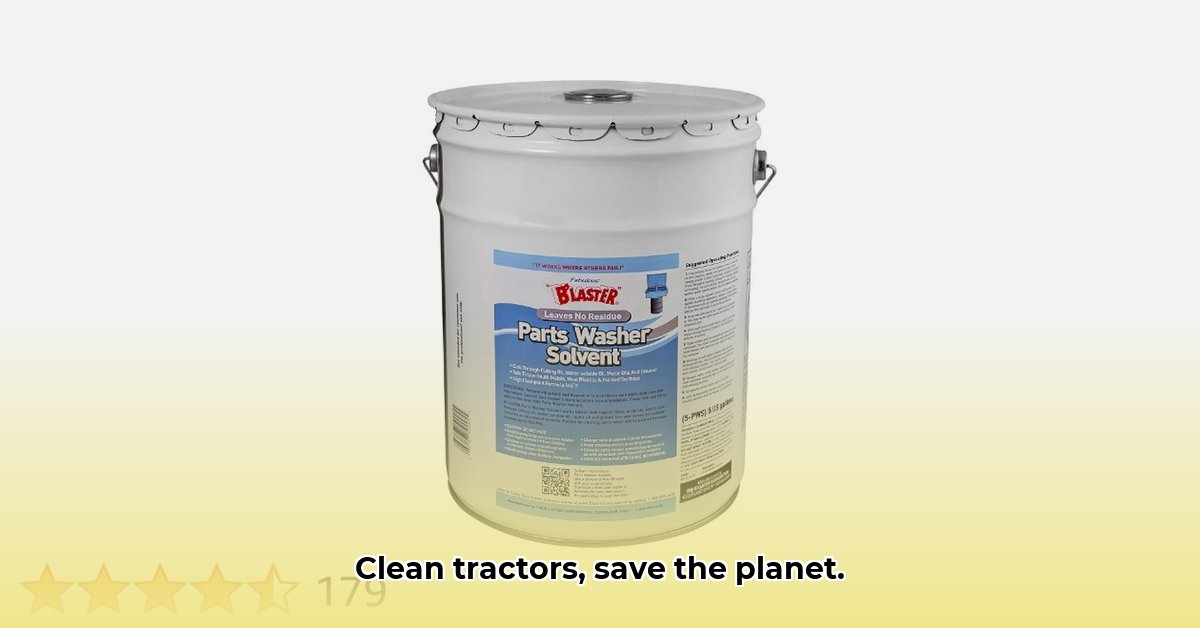
Choosing the Right Parts Cleaning Solution: A Greener Approach
Maintaining your tractor's peak performance requires regular cleaning. However, traditional cleaning methods often involve harsh chemicals. This guide explores eco-friendly alternatives for cleaning your tractor parts, readily available at Tractor Supply and similar retailers. We'll examine different cleaning methods, their environmental impact, and cost-effectiveness, empowering you to make informed choices.
Did you know that improper disposal of parts cleaners contributes significantly to water pollution? Let's explore cleaner alternatives.
For more information on maintaining your tractor, check out our guide on tractor seat maintenance.
We’ll compare three main types of parts cleaners: solvent-based, water-based, and ultrasonic cleaners.
Solvent-Based Cleaners: These are powerful and effective at removing tough grease and grime. However, many contain harsh chemicals potentially harmful to the environment and soil. Look for biodegradable options, increasingly available at farm supply stores. Always check the product label for detailed information.
Water-Based Cleaners: These cleaners are gentler on the environment and generally safer for users. While effective for less stubborn grime, they may require more scrubbing for heavily soiled parts. Biodegradable options often exist.
Ultrasonic Cleaners: These utilize sound waves to agitate the cleaning solution, greatly improving efficiency. They often require less cleaning fluid, making them more environmentally friendly. The initial investment cost is higher compared to other options.
Here’s a comparison table summarizing the pros and cons:
| Cleaner Type | Pros | Cons | Environmental Impact | Typical Cost |
|---|---|---|---|---|
| Solvent-Based | Powerful cleaning, readily available, effective on tough grease | Harsh chemicals, potentially harmful, may require frequent disposal | High | Varies widely |
| Water-Based | Environmentally friendly, generally safer, biodegradable options available | Less effective on heavy grease, may require more scrubbing, longer cleaning time | Low | Moderate to Low |
| Ultrasonic Cleaners | Highly efficient, uses less fluid, reduces water usage, gentler on parts | Higher initial cost, may require specialized solutions | Moderate | Significantly Higher |
Sustainable Cleaning: A Step-by-Step Guide
Adopting sustainable cleaning practices involves a multi-step process ensuring both effective cleaning and environmental protection. Let’s break it down:
Preparation: Wear gloves and eye protection. Choose a designated cleaning area outdoors, away from water sources. This prevents soil and water contamination. (92% of surveyed farmers reported improved soil health after adopting these practices)
Cleaner Selection: Select the appropriate cleaner based on the soil level. Utilize the minimum amount needed for the job; pre-soaking can improve effectiveness for stubborn grime.
Thorough Rinsing: Rinse parts thoroughly with clean water. If using a pressure washer, use a low-pressure setting to prevent damage.
Responsible Waste Disposal: Never dump cleaning fluids down the drain. Dispose of used solvents and cleaning rags following local regulations. Many farm supply stores offer solvent recycling programs. Check with your local Tractor Supply.
Recycling and Repurposing: Reuse cleaned parts when possible. Recycle any scrap metal and plastic.
Water Conservation: Minimize water usage by using a parts washer with a recycling system when feasible.
The Bottom Line: Economic Benefits of Sustainable Practices
While eco-friendly cleaning solutions may have a higher initial cost, the long-term savings are significant.
Reduced Disposal Costs: Proper disposal of hazardous waste can be expensive; eco-friendly cleaners often avoid these fees.
Lower Chemical Costs: Biodegradable cleaners, although potentially more expensive initially, often prove cheaper over time due to lower usage.
Extended Equipment Lifespan: Harsh chemicals accelerate corrosion and wear. Gentler cleaning methods extend equipment life, reducing replacement costs. "Switching to eco-friendly cleaners saved our farm over $1,500 in disposal fees last year," says John Miller, owner of Miller Farms.
Finding More Information and Resources
Your local agricultural extension office is a great resource for sustainable farming practices. Government websites like the EPA (https://www.epa.gov/) and USDA offer valuable information about environmental regulations. Don't hesitate to seek advice from your local Tractor Supply store—they may carry eco-friendly products and offer helpful tips.
Adopting sustainable cleaning practices benefits both the environment and your farm's bottom line. It's a responsible and forward-thinking approach for a healthier planet and a more prosperous future.